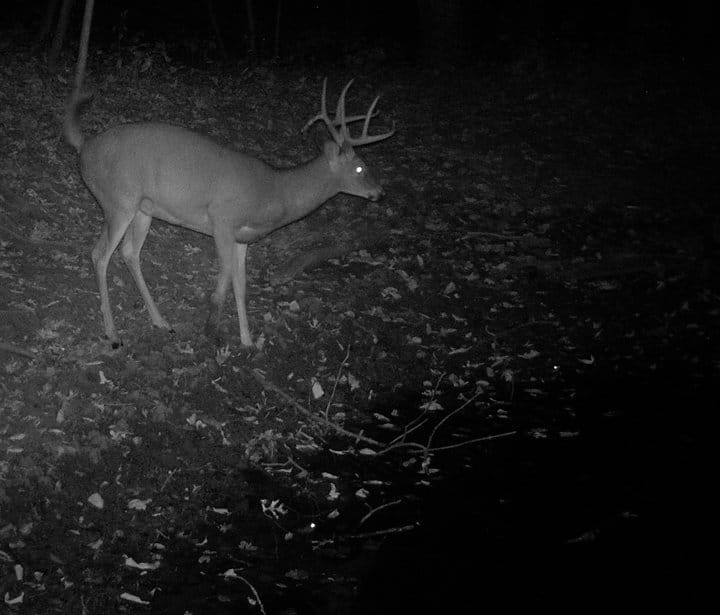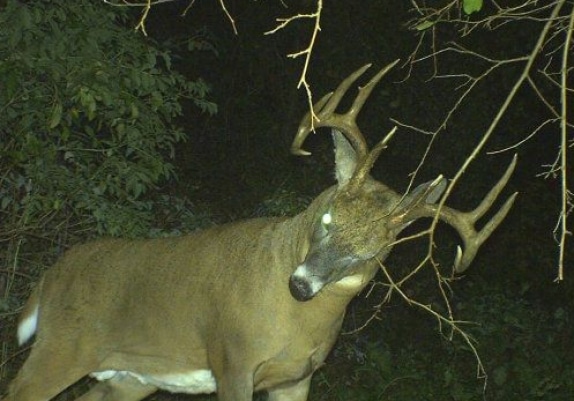Velvet is dropping, bachelor groups are breaking up, and those easy-to-find summer bucks are changing patterns and will soon “disappear” as they spread out into the far corners of their home ranges. It’s time to use your trail-cameras to relocate mature bucks, discover their new fall movement patterns, and set up an opening-day plan. Here are some tips on trail-camera placement for early fall that will get you back in the hunt.
Acorns
Right now, deer are shifting from summer to fall food sources. In the fall, a main attractant for whitetails is acorns. Currently here in Iowa, oak trees have already started to drop their acorns (earlier than other years) and are drawing deer from bean fields into hardwood timber. When available, acorns are one of the strongest natural attractants for deer at any time of year. I move several of my trail-cameras into oak timber during early fall and monitor these areas until acorns are gone and deer are shifting to other food sources.
Food Plots

Corn
Once soybean leaves start to turn yellow and natural forages mature and become less digestible, deer will move into cornfields, whether they are agricultural crops or fields planted for deer. Standing corn can provide both cover and food for deer, so these fields shouldn’t be overlooked. As soon as farmers start to combine their corn, deer will move in to feed on dropped corn. Also, look for fields that have been hit harder by wind or drought. I have found that more corn is left behind by combines in these fields. Cornfield edges will be a prime spot for trail-cameras this fall.
Fruit Trees

Scrapes and Rub Lines
You can get some of your best buck photography this time of year on licking branches over scrapes. As soon as the velvet drops and the first scrapes appear, bucks will start to scent-mark these spots almost daily, and you can quickly inventory the individual bucks using your hunting area. You will find that the majority of scrape activity occurs at night, but you can still learn a lot about which bucks are using which general areas where you hunt. Combine this information with photos from food sources and other sites mentioned here, and you can quickly dial in on likely stand sites. Rub lines can also be productive camera locations, especially larger rubs that are used repeatedly by multiple bucks. Some rubs are used less often, so if bucks don’t show up after a couple of days of monitoring, move your camera to the next line.
Pinch Points
As the weather cools, deer start to move more and more. Place your cameras on trails in major pinch points or funnels between bedding cover and food sources. When placing your camera on a trail, orient the camera at a 45-degree angle to the trail, or straight down the trail (a camera placed perpendicular to a trail may only get you pictures of half the deer, as the deer may already be moving out of the image frame by the time the camera triggers). Start with the main trails leading to food sources, and if you don’t get the buck you’re looking for, move the camera to the next trail. The heaviest used trails will generate the most trail-camera pictures, but I have found the mature buck you are looking for is often using more secretive trails with less traffic.
Water Holes

Scent Control and Timing
Using a trail-camera in the fall can give you a huge scouting/hunting advantage, but don’t forget to keep a low profile when checking trail-cameras as too much human activity and scent can spoil what would otherwise be a great hunting area. Before hunting season, I only check my trail-cameras every two to three weeks, and I practice scent-control techniques just like I’m going hunting. However, during the season, I’ll only check or move a camera on my way out of the woods after a hunt. I will also move trail-cameras more often in the fall. This allows me to keep the human pressure evenly distributed and not concentrated in certain areas while I try to get a handle on buck movement.
Attracting and producing mature bucks through QDM and quality habitat management is one thing; killing those mature bucks is another! A well-placed trail camera can help you stay in touch with those mature bucks as their movement patterns change throughout the fall, increasing your hunting success. So, use these scouting devices to your advantage.
Good luck this season!
Matt Pudenz of Winterset, Iowa, is the creator of TrailCamTrophies.com. This is his first article for QDMA.com.
Did you know the Missouri State Chapter of QDMA contributed to research at the University of Central Missouri that helped identify ways to educate hunters to more accurately identify the sex, antler size and age of deer in trail-camera photos? This is just one example of how QDMA member-volunteers are funding practical deer research that can help deer hunters. You can do the same by joining QDMA today!
